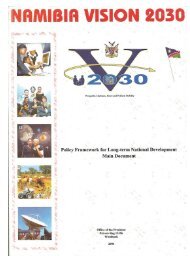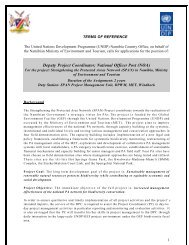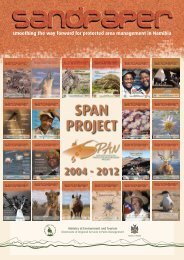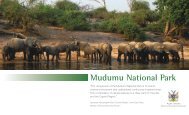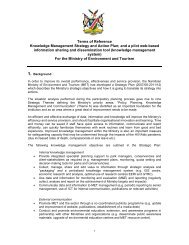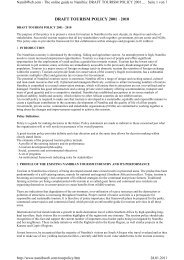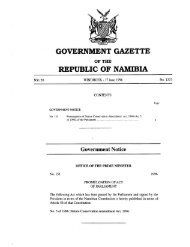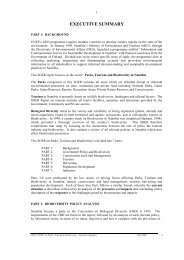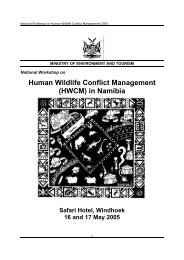Etosha: the Human Footprint - Ministry of Environment and Tourism
Etosha: the Human Footprint - Ministry of Environment and Tourism
Etosha: the Human Footprint - Ministry of Environment and Tourism
Create successful ePaper yourself
Turn your PDF publications into a flip-book with our unique Google optimized e-Paper software.
male <strong>and</strong> female rhinos. Waterberg founders had similar levels <strong>of</strong> expected heterozygosity to<br />
<strong>Etosha</strong> rhinos: He = 0.526 ± 0.014 (±SE) vs. 0.522 ± 0.004, but s lower number <strong>of</strong> alleles:<br />
3.8±0.3 vs. 5.2 ± 0.2. Bayesian analyses (STRUCTURE) showed no genetic structure in <strong>the</strong> 145<br />
rhino under conditions <strong>of</strong> admixture/no admixture <strong>of</strong> source populations <strong>and</strong><br />
correlated/uncorrelated allele frequencies for sexes combined <strong>and</strong> apart. Spatial analyses<br />
(BARRIER) <strong>of</strong> inter-individual genetic distance among all <strong>Etosha</strong> residents (n=110), suggested<br />
no subdivision. However males in <strong>the</strong> northwest appear segregated from o<strong>the</strong>r <strong>Etosha</strong> males.<br />
Inter-individual spatial genetic autocorrelation suggest <strong>Etosha</strong> rhinos are not r<strong>and</strong>omly dispersed,<br />
with females showing greater autocorrelation at lower distance classes than males at 10, 25 <strong>and</strong><br />
40km scales. Although spatial-genetic signals are stronger when limited to 1998-2000 samples, it<br />
is likely to few generations have passed for putative social groups to be genetically differentiated.<br />
Christian Wissel, M. Franz, W. Kilian, J. Groeneveld, S. Kramer-Schadt<br />
Simulation <strong>of</strong> vegetation change caused by elephants around waterholes<br />
A process-based, spatially explicit simulation model is introduced which describes <strong>the</strong> interaction<br />
<strong>of</strong> variable rain fall, woody vegetation dynamics <strong>and</strong> elephant foraging behaviour around<br />
waterholes. An aggregated description <strong>of</strong> <strong>the</strong> vegetation <strong>and</strong> <strong>the</strong> elephants is used which reduces<br />
model complexity <strong>and</strong> number <strong>of</strong> parameters. In this way a good parametrization could be<br />
obtained which reproduces <strong>the</strong> empirical findings sufficiently well. Parameter values for which<br />
no empirical data exist could be determined by pattern-oriented modelling (inverse modelling). In<br />
this procedure field data on <strong>the</strong> spatial distribution <strong>of</strong> elephants at different times <strong>of</strong> day are used.<br />
A sigmoid vegetation gradient around waterholes is found by <strong>the</strong> model. It has been investigated<br />
how its characteristics are influenced by <strong>the</strong> number <strong>of</strong> elephants <strong>and</strong> amount <strong>and</strong> temporal<br />
pattern <strong>of</strong> rain.<br />
Anna Treydte<br />
Does a grazer need trees The attractiveness <strong>of</strong> below-crown grasses in African savannas<br />
The current decline in large tree cover raises questions about <strong>the</strong> importance <strong>of</strong> trees for <strong>the</strong><br />
surrounding flora <strong>and</strong> fauna in African savannas. Trees compete with but also facilitate growth <strong>of</strong><br />
<strong>the</strong> herbaceous layer underneath <strong>the</strong>ir canopies but studies on differences in sub-canopy grass<br />
quality for grazing wildlife have been scarce. We studied <strong>the</strong> nutrient content, structure, st<strong>and</strong>ing<br />
crop, <strong>and</strong> species composition <strong>of</strong> <strong>the</strong> grass layer beneath <strong>and</strong> outside <strong>of</strong> canopies for different<br />
eastern <strong>and</strong> sou<strong>the</strong>rn African savannas over season. Grass leaf nitrogen <strong>and</strong> phosphorus contents<br />
were up to 25% higher beneath than outside canopies in <strong>the</strong> site <strong>of</strong> lowest rainfall <strong>and</strong> soil<br />
fertility. Grass structure <strong>and</strong> species composition differed strongly beneath <strong>and</strong> outside <strong>of</strong> trees,<br />
with <strong>the</strong> tall <strong>and</strong> nutrient-rich Panicum maximum dominating sub-canopy. Sub-canopy grasses<br />
were grazed more than outside <strong>of</strong> canopies, <strong>and</strong> wild herbivore species, such as <strong>the</strong> zebra (Equus<br />
burchelli), grazed more <strong>of</strong>ten than expected underneath canopies compared to open grassl<strong>and</strong>.<br />
We propose that large trees are important grass quality improvers <strong>and</strong>, consequently, provide an<br />
essential food resource for grazing ungulates in savanna ecosystems. Hence, conservation efforts<br />
should aim at protecting trees, particularly in dry <strong>and</strong> dystrophic savannas, as <strong>the</strong>ir sub-canopy<br />
grasses seem to benefit grazing wildlife. Management strategies <strong>of</strong> both protected areas <strong>and</strong><br />
livestock pastures should fur<strong>the</strong>r maintain large trees to ensure sustainable grass resources for<br />
herbivores in African savannas.<br />
Chuck Rumsey<br />
Kunene Regional Ecological Assessment<br />
A regional ecological assessment for <strong>the</strong> Huab, Koigab, Uniab <strong>and</strong> Haunib river catchements is<br />
now underway in Namibia‟s northwest. The assessment is focused on <strong>the</strong> collection <strong>of</strong> detailed<br />
information on <strong>the</strong> region‟s wildlife, ecosystems, <strong>and</strong> l<strong>and</strong> uses, <strong>and</strong> will make use <strong>of</strong> <strong>the</strong> best<br />
available scientific data alongside <strong>of</strong> local <strong>and</strong> traditional knowledge. Information will be<br />
organized <strong>and</strong> mapped in order to build a robust knowledge-based framework that can continue<br />
to grow <strong>and</strong> be shared with local communities <strong>and</strong> decision-makers over time. We view this<br />
ecological assessment as a critical step for <strong>the</strong> establishment <strong>of</strong> coordinated conservation<br />
3



